(Editor’s note: This article was written by Stimhack Editor SimonMoon)
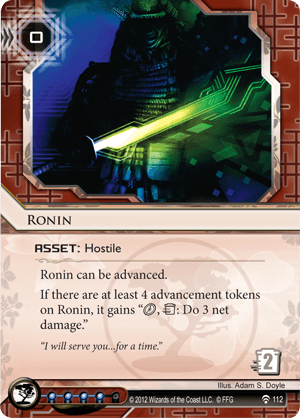
It was great to see how my two articles on Netrunner balance led to lots of discussion, in particular there was a thread of response that I found interesting and led me to having a good think about the nature of the game. The core of the response is found here by /u/eot_factorfiction (as well as in the comments following). The gist of it is that the side Imbalance I described in my earlier articles is due to the Runner being the proactive faction and being able to dictate when runs happen and attack Corp cards. Outside of a few powerful cards (Ronin, Bio-Ethics, Breaking News) the Corp cannot attack the runner the way the Runner is able to attack the Corp. I think eot_factorfiction correctly identifies a core asymmetry in Netrunner, but is wrong about the Corp Cards that break this asymmetry are inherently a negative player experience.
What defines games are their choices and the meaningful choices of the player. What separates single player games from multiplayer games is the nature of the choices you are presented. In multiplayer games, the choices you are presented are influenced by your opponent, whose choices in turn you influence. Much of what makes Netrunner a great game is the plethora of choices you have on both sides of the game and the degree to which your choices create choices for your opponent. These choices often have an optimal answer, but the game is best when the optimal choice is not obvious and is not always the same.
Corporation Threats in Netrunner

The asymmetry of Netrunner is largely driven by the fact that the Runner has an in built means of attack (Click: Run Server) and the Corp does not. There are a couple of important points to be gleaned from this. The first is that running is fundamental to what makes Netrunner a unique game -it allows the Runner to interact with the Corp without playing any cards. The second is that since only the Runner runs, in order for the Corp to be able to interact actively with the runner, they need to be able to pose threats to the Runner through their cards. These threats can take many forms, either in cards that generate powerful resource advantage (Adonis, Sundew, Astro, SanSan) or cards that threaten the runner’s board without them running (Breaking News, Bio Ethics, Ronin). The former are implicit threats, as they do not directly challenge the Runner, but rather say “If you don’t run, the cards I’ve played will allow me to win”. The latter are explicit threats, which say “If you don’t run, the cards I’ve played will allow me to break your board”. Having threats is necessary for the game to function, and having both kinds of threats is beneficial because they present different options to the players.
Diversity of threats to the Runner makes for dynamic and varied gameplay. Even if some people don’t like certain kinds of threats, if you end up having a balanced set of threats, no one has to play what they dislike too much. However, the worst possible state for Netrunner is to remove all threats from Corp and be in a situation where the Runner never needs to run. The unhealthiest decks in Netrunner (Dyper, Spycam Hayley) are decks that completely sacrifice their early board presence and attempt to build up to a board state where they win 100% of the time. These decks never run and take away the primary form of interaction in Netrunner, running, in an attempt to turn the game into Dominion. With these decks the game descends into a race where the Corp is trying to advance their board fast enough versus a Runner who is trying to build their board into its lock state. To be clear, I think it’s okay that a deck can have a strong late game, but the late game should not be so strong that it can win without an early challenge to the Corporation at all.
Good Threats, Bad Threats
While it’s necessary (and good) for there to be both implicit and explicit threats on the Corp side, not all threats are good. The primary way to measure a threat is by the number and quality of options the Runner has to deal with it, as options mean choices and choices are what make games great. For almost any threat in Netrunner the Runner has the ability to try and respond to the threat by winning before the threat wins the game for the Corporation. On top of this, threats can be balanced by opening up other servers to attack. If the Corporation has to spend money to create a threat, this naturally strengthens the options of attacking Central servers. Even without slotting hate cards, just by building a deck that can break Ice, the Runner should have the means of responding to threats in some capacity. I’ll discuss some implicit and explicit threats in NBN that I think are healthy or unhealthy and I’ll focus on how they can be attacked without any tech cards.
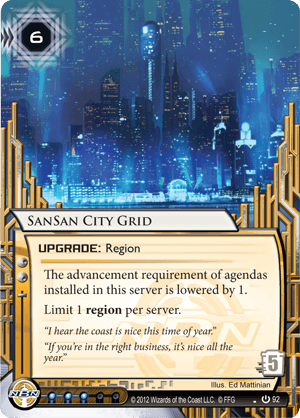
SanSan City Grid
SanSan City Grid is one of the classic NBN power cards and is an example of a healthy implicit threat in Netrunner. Once rezzed, the Runner is forced to respond in some way or the Corp will be able to safely FA multiple agendas, quickly winning the game at low risk. It also represents a threat before it is rezzed, and in both cases offers counterplay opportunities. The runner can trash the SanSan, deny econ to prevent scoring, R&D lock, or try to steal agendas out of HQ. Notably, since Sansan costs 6 to rez, and additional money on Ice to Rez, it does weaken the Corporation and often opens them up to counterattack, so letting one agenda go through and then counter attacking with Medium is often a reasonable tactic. While strong, SanSan is a significant resource investment that opens up Runner counter play and options to challenge the threat.
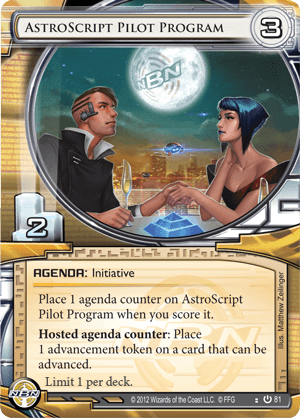
Astroscript Pilot Program
AstroScript is another implicit threat in Netrunner, and as a card that was later restricted, was obviously an unhealthy threat for the game when three copies per deck are allowed. In the AstroTrain days it was insanely powerful once scored. The only option against it immediately became “maximize accesses to try and score enough points before AstroScript chained into victory”. Tools like Clot and Turntable made AstroScript a mildly more reasonable card, but while it succeeded in forcing runs, the nature of its power led to counterplay that was extremely narrow.
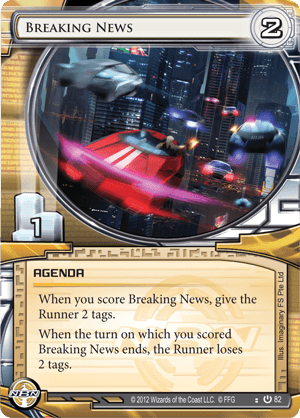
Breaking News
With the limiting of Astro, Breaking News has turned into NBN’s newest power agenda, but one that is a healthy explicit threat. Unlike Astro, where there is no reason not to score it as soon as you can, Breaking News requires three things to be scored usefully: a way of scoring, ideally with a click remaining, and a tag punishment card. This means it tends to stick in hand more because it requires an additional card in order to be useful . Additionally, the nature of tag punishment means the Runner often has a great deal of control over how vulnerable they are. The Runner has the ability to offshore credits on multiple Resources in order to play around Closed Accounts, and Exchange of Information basically requires a 5/3 to be stolen by the Runner. The Runner can challenge Breaking News by stealing from hand during the increased setup time, dealing with the tag punishment (which is less powerful than Astro normally). The way Breaking News is able to attack the Runner is a very compelling dynamic and makes playing around Breaking News very unique.

24/7 News Cycle
There’s one aspect of Breaking News I didn’t totally talk about in the last paragraph, and that is its interaction with meat damage. Typically, to kill a runner you needed two meat damage cards in hand, and the ability to score Breaking News as a 4 advance agenda (giving you the two extra clicks needed). These additional requirements are all subverted by 24/7 News Cycle.This is an unhealthy threat card. It removes the requirement to wait to score Breaking News until your kill turn and allows you to simply score the Breaking News as soon as it’s drawn, which removes a point of attack for the Runner. What ends up being the counterplay to 24/7 is either: A) never letting the Corp score a BN (which they can always do on turn one) or B) scoring out before the Corp can find enough cards. These are extremely limited options.
Lesson on Threat Design
There are some important lessons we can draw from these threats:
- Threats are what drive interaction in Netrunner. Even though all these cards are strong and above the curve in power level, having threats are necessary to force the Runner to do something.
- Threats should be printed as Assets, Upgrades, and Agendas because these are the cards the runner inherently have the most ability to interact with (Steal or Trash) without needing any tech. 24/7 is unhealthy largely because it represents a threat where the cards you need are Operations, where there are no means of attacking the threat without special hate cards.
- Explicit threats are good for the game, as they provide a different kind of interaction that requires different kinds of counterplay.
Faction Threats
In many ways, the quality of a faction is defined by the quality of its threats. I used NBN because they have strong examples of each kind of threat, and they even have another strong threat that I did not list (Sensie Actors Union). As such, it should not be shocking that NBN had a plethora of decks represented in the Top 16 at worlds. At the opposite end of the threat spectrum is Weyland, who have only ever had the threat of scoring out. Their scoring plan has not gotten much better in the past three years and they’ve been the worst faction for as long (though Jemison potentially represents a change in that direction). Weyland’s few good decks have either had their threats become not strong enough (Bootcamp Glacier) or be nerfed due to everyone hating them (Mumbad City Hall). Giving Weyland a power card that threatened a durdling runner would go a long way to fixing their problems. HB is in a pretty good place with strong implicit threats that the runner needs to respond to. Jinteki has had its best implicit threat combo nerfed (Nisei Mk2, Sundew) due to Rumor Mill breaking their end game, but Bio-Ethics and Ronin give them a strong implicit threat that does win games.
Ice
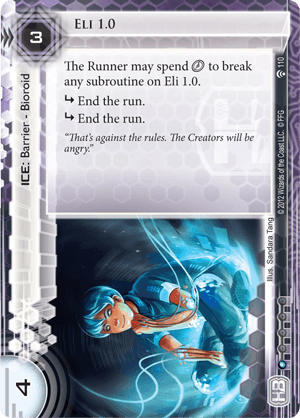
In this discussion of threats, there has been one type of Corp card noticeably missing: Ice. In Netrunner Ice does not act as a threat, but instead acts to protect your threats. The threats of Netrunner are what force the Runner to interact with Ice, which is what makes Netrunner Netrunner and not Netinstaller. What it would mean for Ice to be a threat is that the Corporation was able to install Ice on a server fast enough and at a rez cost low enough that they’re able to create a server the runner is not able to run 3-4 times in a game. The issue with that strategy is this: the Runner is either able to get into this giant server 3-4 times (in which case Ice on its own is not a viable threat), or the Runner is not able to in which case the counterplay is limited to counter attacking other servers. The additional negative effect of this strategy being good is the power creep needed to make Ice good enough to win on its own. Because central servers require more accesses per point, a single Ice in this new Ice powered world would be enough to protect HQ / R&D from the Runner ever being able to get enough accesses.
What makes Glacier healthy is that it requires Assets like Sundew, Adonis, or Eve to give the Corp enough money to build a strong remote fast enough.This allows the Runner to have counterplay of fighting against the econ of the Corp. Additionally, defensive upgrades open the Corp up to counterplay as they represent a non-permanent tax on the server (whereas Ice is there “forever”). Defensive upgrades are also vulnerable to econ denial while rezzed, whereas once rezzed Ice is there forever (outside of destruction). The combination of accelerating Assets and Defensive Upgrades ends up with Glacier being an archetype where the runner needs to run more than 3-4 times on the scoring remote. This does two things: First, the remote game becomes less binary (the difference between running 7 or 8 times on a remote is less than 3 or 4); Second, with more runs required, there are more runs in the game, which means more interaction and more Ice breaking, which are generally thought of as the central component of Netrunner.
Conclusion
Interaction and decisions are the core of any multiplayer game, and Netrunner is largely the game it is because of the strength of the run mechanic. However, behind the run itself are the threats the Corp needs to force the Runner to run, rather than just building into an unbeatable board. These threats can come in many forms, and having a strong variety of threats leads to a range of viable and compelling game play. The key insight about threats is they should be on top of Agendas, Assets, and Upgrades leading to a game inherently around the run – as no other special cards are needed for the Runner to interact with them, and the Runner can come in with a strong general gameplan. Finally, current balance issues between the factions are the result of threat imbalance between the worst faction (Weyland) and the best faction (NBN).
If you enjoyed part 1, check out part 2 of this article: Actually, Parasite is Good and Icebreakers are Bad




